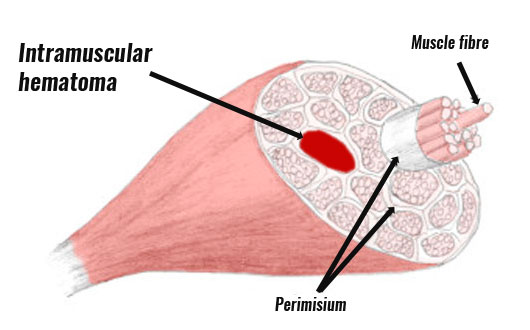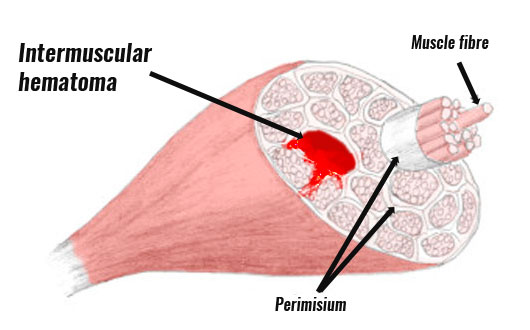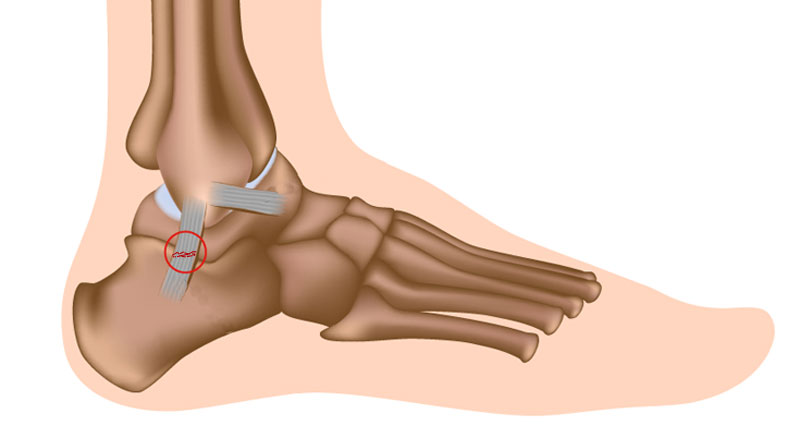Contusions occur in a muscle following direct impact or trauma. Sometimes referred to as a ‘Charley horse’ or a ‘dead leg’, common sites are in the thigh, lower leg, shoulder, and arm.
Common contusions
The following are common contusions in sports:
Contusion symptoms
Direct trauma to the muscle results in:
- Immediate pain at the site of the injury
- Contracting the injured muscle is painful
- Swelling may quickly appear over the area
- Bruising may or may not develop later
Depending on the severity of the injury, the patient may have continued to play, or they may be unable to move or walk.
We grade contusions 1, 2, or 3 depending on severity. The following are examples for grading a thigh contusion:
Grade 1 contusions
The muscle feels tight and the patient may walk with a limp. There is unlikely to be much swelling. Trying to straighten the knee against resistance probably won’t produce much pain. The patient will still have nearly a full range of motion when stretching the muscle.
Grade 2 contusions
The patient is unlikely to be able to walk properly. There will be occasional sudden twinges of pain during activity, possible swelling and straightening the leg against resistance reproduces pain. Pressing in over the site of injury will be painful and the patient will be unable to fully bend the knee.
Grade 3 contusions
The patient will be unable to walk with the aid of crutches. They will be in severe pain and significant swelling will appear immediately. Contracting the muscle may produce a visible bulge or gap in the muscle. Expect to be out of competition for 3 to 12 weeks.
What is a contusion?
Contusions occur in any muscle, with the hamstrings and calf muscles being common locations. Hard impact results in local muscular damage and bleeding. The muscle is crushed against the underlying bone. Bleeding occurs creating a hematoma.
Contusions are common in contact sports during tackles and also in events where a hard object (such as a ball) moves at a high pace. Contusions should not be confused with a muscle strain, which tends to occur as a result of a sudden movement or burst of speed, and should be treated slightly differently to strains.
Intramuscular vs intermuscular contusions
Skeletal muscles are made up of bundles of muscle fibres. The muscle is surrounded by a protective sheath called the Epimysium. Contusions are either intramuscular or intermuscular depending on whether the bleeding is contained within the muscle sheath, or whether the sheath is also damaged and the muscle bleeds outside the muscle sheath.
Intramuscular hematoma

- Intramuscular hematoma is a tearing of the muscle within the sheath that surrounds it.
- This means that the initial bleeding may stop early within hours because of increased pressure within the muscle, however, the fluid is unable to escape as the muscle sheath prevents it.
- The result is considerable loss of function and pain, which can take days or weeks to recover.
- You are not likely to see any bruising come out with this type – especially in the early stages.
Intermuscular hematoma

- Intermuscular hematoma is a tearing of the muscle and part of the sheath surrounding it.
- This means that the initial bleeding will take longer to stop, especially if you do not ice it.
- However, recovery is often faster than intramuscular as the blood and fluids can flow away from the site of injury.
- You are more likely to see bruising come out with this one.
If after two to three days the swelling has not gone, then it is probably an intramuscular injury (bleeding contained within the muscle). However, if the bleeding has spread and caused bruising away from the site of the injury then it is probably an intermuscular injury. Intermuscular contusions often result in the patient having greater movement and the ability to contract the muscle.
Treatment for contusions
- Immediate treatment of a contusion should involve rest and cold therapy application.
- The injury should also be elevated and a compression bandage or support applied, to help minimise bleeding and swelling.
- This protocol should be continued until all bleeding has stopped.
- Only when this is certain, should other treatments which may put heat into the muscle, be applied.
Myositis ossificans
- Treatment of a contusion should be quite cautious. Continuing to play after injury, over-aggressive treatment or applying heat or massage too soon to the injury can result in the development of myositis ossificans. This is where the hematoma (bleed) calcifies and a bony growth develops within the muscle. This can affect the muscle’s function on a long-term basis.
Read more on myositis ossificans.







